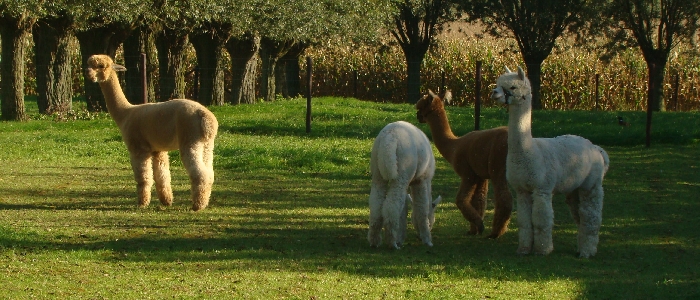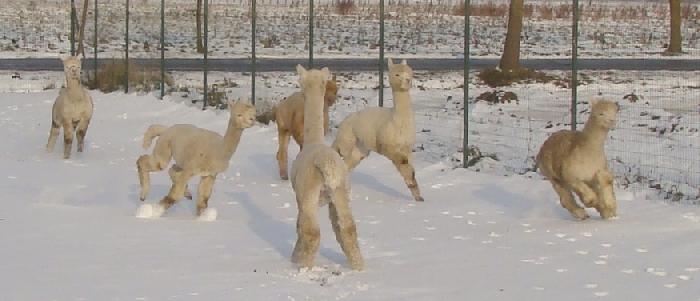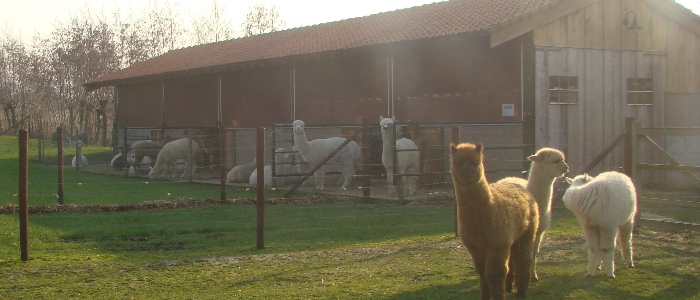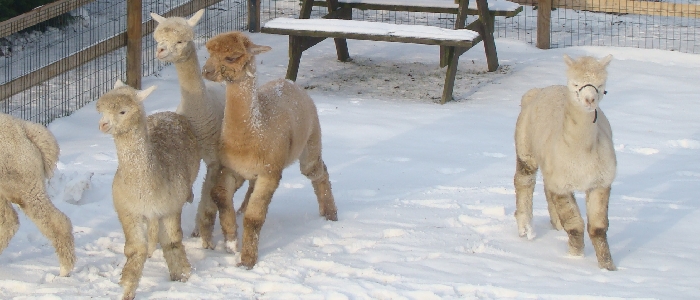Voeding Cria
FEEDING CRIA
By Linda Blake Southern Alpacas Stud
Cria have no antibodies when born, and are unable to fight infection and disease. Cria obtain antibodies from their mother’s milk.
The first milk is a creamy sticky milk, called colostrum, with high levels of antibodies in it. A cria’s bowel can only absorb these antibodies in the first 12 to 24 hours of life.
Make sure that your cria is feeding in the crucial first 24 hours.
Observe the feeding behaviour - how often, and if satisfactory. If a cria is seeking milk, it will find it if it is there. A cria who has found the milkbar will usually curve its tail up, and will put its tail down once it begins to actually feed.
Check that the cria is getting milk - look for a milky moustache. If you are unsure, wait until it has been under mum, then put your finger in its mouth to check for milk.
If a cria misses out on colostrum, it will be prone to infection. Alpacas can be tested for antibodies, by measuring IgG levels. A transfusion of alpaca plasma can provide the vital antibodies if the cria misses out from inadequate initial feeding.
If your cria is not feeding, assist it.
Ensure the dam’s teats are clear of wax, and milk is flowing. The milk will flow better once the placenta is passed.
You may need to hold the cria under the dam, making sure it gets to the right place. If so, position yourself at the dam’s rear legs, so when the dam turns around to check what is going on, it is her cria she sees and sniffs.
The best alpaca supplementary feed is Anlamb, according to Agresearch, who tested various substitute milks on alpacas. Make up the Anlamb as for the lamb dose. (You can as much as double this amount.) We add a tablespoon of glucose per 500 ml milk.
Or, use a bottle of milk, including colostrum, milked from its own mother. Alpacas are not easy to milk, as they produce milk little yet often. Milk can be expressed from the teats using a 10ml syringe with its top narrow neck cut-off. Put the wide end of the syringe (un-cut end) on the udder, and draw the plunger back. Decant it into a sterile container, out of kicking distance !
You can use colostrum from, in order of priority, another alpaca or llama, an artificial substitute, or a cow, goat or sheep. We use ColoZen, which comes in two bottles, and is kept in the fridge, and is made up at the time we require it. Don’t make up the whole bottle - a teaspoon of powder with 15 ml of the fluid makes enough ColoZen for 5 doses of 3ml, one in each of the first 5 feeds.
Keep all equipment sterile - we use Virkon.
Continue to monitor feeding. Indicators of poor feeding are frequent attempts to suckle (more than once an hour), weakness and lethargy, sitting a lot, poor weight gain or weight loss, and no milk moustache after feeding.
Monitor the progress of the cria. Weigh regularly - daily initially. Plot a chart of weights of all your cria, to notice any different growth patterns. Weigh them weekly until over 20 kg.
The weight of the cria may drop by 10% in the first couple of days, but once the milk supply is fully in, cria weight gain should be 1 to 1.5 kg a week.
Cria are active, and move and play a lot. Day one they stay close to mum, day two they run away about 10 metres from mum, and by day three they will explore 30-40 metres from mum.
A sluggish cria, resting more, and drinking less, not gaining weight, is of concern. Take its temperature if you have any concerns about its health. Cria should be between 37 and 39 C. Outside this range, call the vet.
Aim to feed the cria 10% of its body weight daily. Crias are snackers, needing frequent small feeds. Feed at 4 hourly intervals, with 6 feeds a day, from daybreak to late evening. You do not need to feed in the early hours of the morning, as alpacas sleep then.
As an example, a 6 kg cria gets a minimum of 600 mls a day, in 6 feeds of 100 ml.
A plastic bottle, with a lamb teat, is suitable for cria feeding. Keep all cria feeding equipment sterile, as you would for a human baby, using boiling water and a disinfectant like Virkon.
An exception to this feeding regime is very small frail cria. They may need feeding every 1.5 to 2 hours, around the clock, for the first three days. Get specialist advice and assistance.
Cria head for dark areas to nurse, like shed corners. Put a light on in a shed, so the darkest spot is under mother, as it would be in the paddock.
Make the cria stand to feed, and stretch its neck up to simulate the natural feeding position. This aids the milk to go in the correct stomach.
I find it easiest to achieve this posture by straddling the cria, restraining it with my knees, and having one hand to guide its head back towards me and one hand to hold the bottle.
Make sure the cria sucks, so the milk goes down the throat, not squirted into its airways. Keep the airhole in the base of the teat on the upper side for air to go in and help the milk to go out.
Poor suckers can be assisted to drink. Pop your finger in its mouth, then slide the teat in. Hold its mouth closed and slowly stroke its throat to encourage it to swallow. This may take three hands initially (a second person to do the throat stroking), but it is possible with two hands.
Cria that will not suck can be stomach tubed - a job for your vet.
Keep the cria with its mother, and encourage it to feed from her - most will use mum if possible, and may even run to have a snack from mum after the less palatable human-provided milk. Cria will eventually reject the bottle if mum is feeding them enough.
As the cria gets older it will take the bottle front-on.
Bottle fed cria should be kept with the herd, to minimise them imprinting on the human feeder. It is tempting to pat and cuddle them, but this can cause problems later as they come into adolescence and adulthood, when they show no respect for the human that helped them survive.
Orphan cria feeding can follow the Anlamb package recommendation for lambs for the first three weeks. Reduce down the bottle frequency to 3, then 2, then a single feed a day as the cria grows. You may like to reduce the quantity and/or the milk strength over time to wean off gradually as well. Orphan cria need feeding until 4 or 5 months old.
CRIA FEEDING KIT
Plastic bottle - small soft drink 500ml size with screw thread
Lamb teats with a flutter valve - the air hole with ball bearing in it
Anlamb - best substitute milk
Glucose - for extra energy and sugar
Measuring jars to shake and make up milk
Funnel and strainer (ensure no lumps)
Bottle brush, bowl, disinfectant solution like Virkon to keep things sterile
ColoZen or similar colostrum substitute in fridge OR
Colostrum frozen in freezer in small quantities like ice cube tray
Cut-down syringe to milk the dam
Electrolyte solutions - for hydration
[2009-02-23 door Linda Blake]







